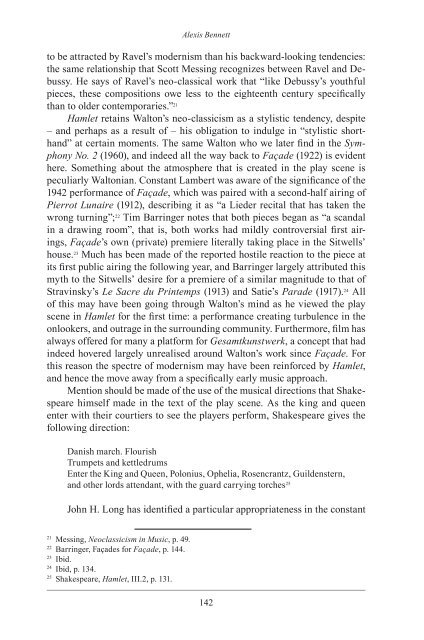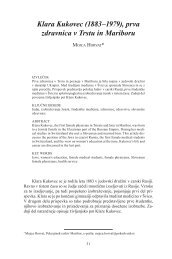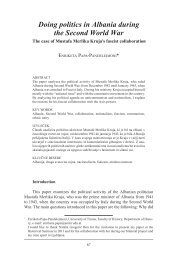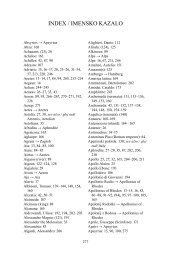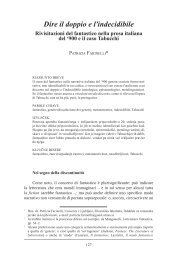HS 9 - HistoriÄni seminar ZRC SAZU
HS 9 - HistoriÄni seminar ZRC SAZU
HS 9 - HistoriÄni seminar ZRC SAZU
Create successful ePaper yourself
Turn your PDF publications into a flip-book with our unique Google optimized e-Paper software.
Alexis Bennett<br />
to be attracted by Ravel’s modernism than his backward-looking tendencies:<br />
the same relationship that Scott Messing recognizes between Ravel and Debussy.<br />
He says of Ravel’s neo-classical work that “like Debussy’s youthful<br />
pieces, these compositions owe less to the eighteenth century specifically<br />
than to older contemporaries.” 21<br />
Hamlet retains Walton’s neo-classicism as a stylistic tendency, despite<br />
– and perhaps as a result of – his obligation to indulge in “stylistic shorthand”<br />
at certain moments. The same Walton who we later find in the Symphony<br />
No. 2 (1960), and indeed all the way back to Façade (1922) is evident<br />
here. Something about the atmosphere that is created in the play scene is<br />
peculiarly Waltonian. Constant Lambert was aware of the significance of the<br />
1942 performance of Façade, which was paired with a second-half airing of<br />
Pierrot Lunaire (1912), describing it as “a Lieder recital that has taken the<br />
wrong turning”; 22 Tim Barringer notes that both pieces began as “a scandal<br />
in a drawing room”, that is, both works had mildly controversial first airings,<br />
Façade’s own (private) premiere literally taking place in the Sitwells’<br />
house. 23 Much has been made of the reported hostile reaction to the piece at<br />
its first public airing the following year, and Barringer largely attributed this<br />
myth to the Sitwells’ desire for a premiere of a similar magnitude to that of<br />
Stravinsky’s Le Sacre du Printemps (1913) and Satie’s Parade (1917). 24 All<br />
of this may have been going through Walton’s mind as he viewed the play<br />
scene in Hamlet for the first time: a performance creating turbulence in the<br />
onlookers, and outrage in the surrounding community. Furthermore, film has<br />
always offered for many a platform for Gesamtkunstwerk, a concept that had<br />
indeed hovered largely unrealised around Walton’s work since Façade. For<br />
this reason the spectre of modernism may have been reinforced by Hamlet,<br />
and hence the move away from a specifically early music approach.<br />
Mention should be made of the use of the musical directions that Shakespeare<br />
himself made in the text of the play scene. As the king and queen<br />
enter with their courtiers to see the players perform, Shakespeare gives the<br />
following direction:<br />
Danish march. Flourish<br />
Trumpets and kettledrums<br />
Enter the King and Queen, Polonius, Ophelia, Rosencrantz, Guildenstern,<br />
and other lords attendant, with the guard carrying torches 25<br />
John H. Long has identified a particular appropriateness in the constant<br />
21<br />
Messing, Neoclassicism in Music, p. 49.<br />
22<br />
Barringer, Façades for Façade, p. 144.<br />
23<br />
Ibid.<br />
24<br />
Ibid, p. 134.<br />
25<br />
Shakespeare, Hamlet, III.2, p. 131.<br />
142


